Citation
Liew, Ngoh Chin and Alemany, Gina V. and Angchaisuksiri, Pantep and Bang, Soo M. and Choi, Gordon and De Silva, Deidre A. and Hong, Ji M. and Limi, Lee and Li, Yong J. and Rajamoney, Ganesan N. and Suviraj, John and Tan, Thiam C. and Tse, Eric and Teo, Li T. and Visperas, Julie and Wong, Raymond S. and Lee, Lai H.
(2017)
Asian venous thromboembolism guidelines: updated recommendations for the prevention of venous thromboembolism.
International Angiology, 36 (1).
pp. 1-20.
ISSN 0392-9590; ESSN: 1827-1839
Abstract
The Asian venous thromboembolism (VTE) prophylaxis guidelines were first published in 2012. Since its first edition, the Asian Venous Thrombosis Forum (AVTF) working group have updated the Asian VTE epidemiology and reviewed issues that were not addressed in the previous guidelines. The authors noted that the rising incidence of VTE across Asia may be attributable to aging population, dietary changes, and increasing incidence of obesity and diabetes. The new additions in the guideline include role of thrombophilia in VTE, bleeding risk in Asians, individual risk assessment, updates in the prevention of VTE in medically ill, bariatric surgery, cancer, orthopedic and trauma patients. The influence of primary thrombophilia in perioperative VTE is still unclear. The secondary risk factors, however, are similar between Asians and Caucasians. The group found no evidence of increased risk of bleeding while using pharmacological agents, including the use of novel anti-coagulants. At present, Caprini risk assessment model is widely used for individual risk assessment. Further validation of this model is needed in Asia. In medically ill patients, pharmacological agents are preferred if there is no bleeding risk. Intermittent pneumatic compression device (IPC) is recommended in patients with bleeding risk but we do not recommend using graduated compressive stockings. In bariatric patients, data on VTE is lacking in Asia. We recommend following current international guidelines. A high index of suspicion should be maintained during postbariatric surgery to detect and promptly treat portomesenteric venous thrombosis. Different cancer types have different thrombotic risks and the types of surgery influence to a large extent the overall VTE risk. Cancer patients should receive further risk assessment. In patients with higher thrombotic risk, either due to predisposing risk or concomitant surgery, low molecular weight heparin is indicated. Different countries appear to have different incidence of VTE following trauma and major orthopedic surgery. We recommend mechanical prophylaxis using IPC as the main method and additional pharmacological prophylaxis if the thrombotic risk is high. As for obstetric practice, we propose adherence to the UK Greentop guideline that is widely accepted and utilized across Asia. To improve VTE thromboprophylaxis implementation in the region, we propose that there should be better health education, establishment of hospital-based guidelines and multidisciplinary collaboration.
Download File
![[img]](http://psasir.upm.edu.my/60930/1.hassmallThumbnailVersion/Asian%20venous%20thromboembolism%20guidelines%20updated%20recommendations%20for%20the%20prevention%20of%20venous%20thromboembolism.pdf)  Preview |
|
Text (Abstract)
Asian venous thromboembolism guidelines updated recommendations for the prevention of venous thromboembolism.pdf
Download (6kB)
| Preview
|
|
Additional Metadata
Actions (login required)
 |
View Item |

